Island vertebrate consumers of marine crustaceans and fish are particularly susceptible to seasonal fluctuations of oceanographic conditions. The endemic fish-eating myotis (Myotis vivesi) is restricted to a few insular ecosystems in the Gulf of California, where it feeds on both marine and terrestrial prey; yet it is unknown whether its diet covaries with marine primary productivity. We determined the relative contribution of marine and terrestrial food sources to the diet of the fish-eating myotis to test the hypothesis that seasonal changes in oceanic primary productivity would dictate general feeding patterns of this bat species. We predicted that marine food would predominate in the diet of the bat during winter followed by an increase in importance of terrestrial food sources as summer approached. We measured amount of feces deposited in the day roost per bat and extrapolated this value to estimate amount of feces deposited in 1 year by the fish-eating myotis population in Partida Norte Island. Carbon and nitrogen stable isotope analysis of bat blood and examination of food remains in feces showed that marine food was the main source of nutrients for fish-eating myotis throughout the year. Importance of terrestrial food was marginal during most of the year, with a modest increase in summer. Estimated annual feces production was up to 1,518 kg. Because of its predominantly marine feeding habits, fish-eating myotis transfer allochthonous nutrients to islands where they roost, subsidizing the nutrient and energy economy of the islands.
Los vertebrados insulares que se alimentan de crustáceos y peces marinos son particularmente susceptibles a las fluctuaciones estacionales de las condiciones oceanográficas. El murciélago endémico myotis pescador (Myotis vivesi) está restringido a los ecosistemas insulares del Golfo de California, donde se alimenta de presas marinas y terrestres; sin embargo, no se sabe si su dieta varía con la productividad primaria marina. Nosotros estimamos la contribución relativa de fuentes de alimento marinas y terrestres en la dieta del myotis pescador para poner a prueba la hipótesis de que los cambios estacionales en la productividad primaria oceánica determinan los patrones generales de alimentación de esta especie. Se predijo que los alimentos de origen marino predominan en la dieta del murciélago durante el invierno, y que la importancia de los alimentos de origen terrestre aumenta conforme se acerca el verano. Además, se midió la cantidad de heces fecales depositadas en los refugios diurnos por cada individuo y se extrapoló este valor para estimar la cantidad depositada en un año por la población de myotis pescador en la Isla Partida Norte. Los análisis de isótopos estables de carbono y nitrógeno de la sangre de murciélagos y el examen del contenido de restos de alimentos en las heces demostraron que el alimento marino fue la principal fuente de nutrientes proteinas a lo largo del año para el myotis pescador. La importancia de las fuentes de alimento terrestre fue marginal durante todo el año, con un incremento modesto en el verano. La producción anual de heces estimada fue de hasta 1,518 kg. Debido a sus hábitos alimentarios predominantemente marinos, el myotis pescador transfiere nutrientes alóctonos a las islas donde se refugia, subsidiando ási la economía de nutrientes y energía de estas.





